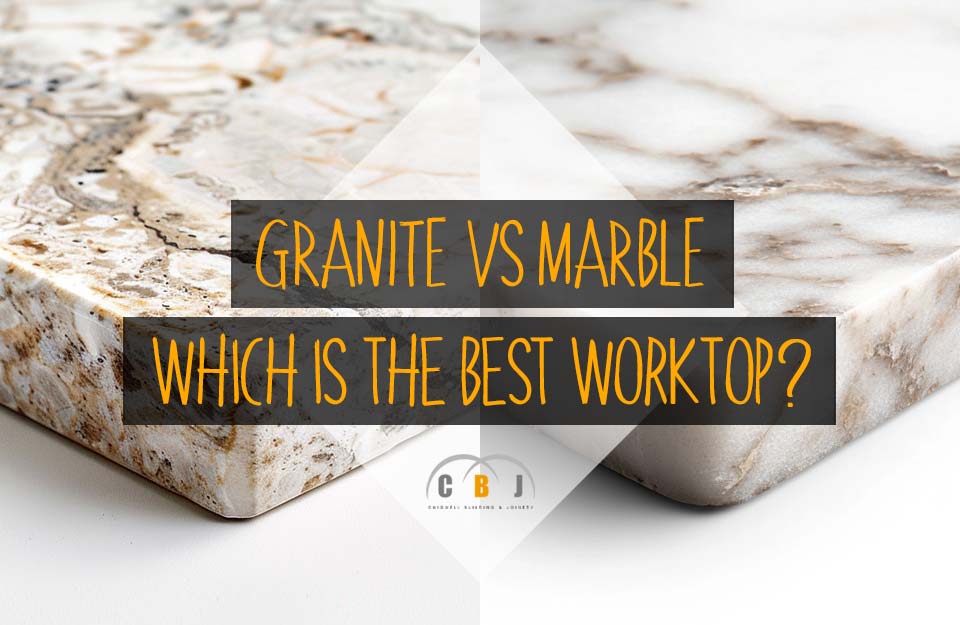
Granite vs Marble - Which is the Best Worktop?
Author Chigwell Building & Joinery
Date 13/02/25
Granite and marble are two of the most sought-after worktop materials for kitchen carcasses, each offering unique benefits and aesthetics.
Choosing between them requires understanding their properties, advantages, and limitations.
Both materials bring a timeless aesthetic and a sense of elegance to any kitchen.
However, they also differ significantly in terms of durability, maintenance, cost, and various other factors.
In this guide, we’ll explore the key differences to help you determine which material is better suited to your needs.
Table of Contents
- What is Granite?
- What is Marble?
- Key Differences
- Origins
- Appearance
- Imperfections
- Durability
- Stain Resistance
- Marks and Scratching
- Care and Maintenance
- Heat Resistance
- Strength
- Longevity
- Water Resistance
- Design
- Installation
- Cost
- Added Value
- Conclusion
What is Granite?
Granite is a natural igneous rock formed through the slow crystallisation of magma beneath the Earth's surface.
Its composition primarily includes quartz, feldspar, and mica, giving it a granular texture and distinctive speckled appearance.
Granite’s natural origin ensures that every slab is unique, featuring a blend of colours and patterns.
Its hardness and durability make it a popular choice for high-use areas such as kitchens.
Granite is quarried from various parts of the world, including Brazil, India, and Italy, which often influences its price and availability.
Once extracted, the stone is cut, polished, and sealed for use as a countertop material.
What is Marble?
Marble is a metamorphic rock created when limestone undergoes intense heat and pressure within the Earth’s crust.
This process alters its composition and structure, resulting in its smooth, veined appearance.
Unlike granite’s speckled patterns, marble is characterised by flowing veins that provide a more cohesive and elegant aesthetic.
Marble has been associated with luxury and sophistication for centuries, often used in sculptures, architecture, and interiors.
Its softer nature makes it more prone to scratches and stains, but with proper care, it remains a stunning and timeless addition to any kitchen.
Key Differences
Granite and marble differ significantly in terms of their origin, appearance, durability, and more.
While granite is harder and more resistant to scratches and heat, marble is prized for its elegance and unique veining.
Origins
Granite is formed deep within the Earth’s crust from cooling magma, giving it a crystalline structure and speckled appearance.
Marble originates from limestone subjected to immense heat and pressure, resulting in its iconic veining and smooth texture.
Before reaching kitchen countertop manufacturers, both materials are sourced from quarries.
Granite is predominantly mined in countries such as Brazil, India, and South Africa, while marble is often extracted from regions renowned for their deposits, like Italy, Greece, and Turkey.
Quarries use advanced cutting equipment to extract large blocks of stone, which are then transported to processing facilities.
There, the blocks are sliced into slabs, polished to enhance their natural beauty, and treated to prepare them for use as premium kitchen surfaces.
Appearance
Granite offers a broader range of colours and patterns, from subtle whites and blacks to vibrant reds, greens, and blues.
Its intricate patterns and speckles ensure that no two slabs are identical, making each worktop unique.
Marble is often associated with sophistication, thanks to its elegant veining and softer, more uniform colour palette.
White and grey marble are especially popular, lending a classic and timeless look to both modern and traditional style kitchens.
Imperfections
Granite’s granular composition often hides minor scratches and imperfections, making it more forgiving in busy households.
Marble, while beautiful, can showcase its natural flaws more prominently, including variations in veining and slight fissures.
These imperfections are often seen as part of its charm but may not appeal to those seeking a flawless finish.
Durability
Granite is one of the hardest natural stones, making it highly resistant to scratches, chips, and everyday wear and tear.
This durability makes it ideal for high-traffic kitchens.
Marble is softer and more prone to scratches and chips.
It’s best suited for areas where heavy-duty use is less frequent, or for homeowners who are committed to careful maintenance.
Stain Resistance
Granite is more resistant to stains, particularly when sealed properly.
Its dense composition helps prevent liquids from penetrating the surface.
Marble is porous and more prone to staining, especially from acidic substances like wine, coffee, and citrus fruit.
Regular sealing is essential to minimise the risk of permanent marks.
Marks and Scratching
While granite can withstand sharp objects and heavy kitchen use, it’s always a good idea to use chopping boards to protect the surface.
Marble is more susceptible to etching from acidic foods and can show scratches more readily.
Protective measures are crucial to maintaining its pristine appearance.
Care and Maintenance
Both materials require some level of maintenance, but granite is generally easier to care for.
Regular cleaning with mild soap and occasional resealing (every 1-2 years) will keep it in excellent condition.
Marble demands more frequent sealing and the use of pH-neutral cleaners to avoid damage.
It’s best for homeowners willing to invest time in its upkeep.
Heat Resistance
Granite is highly heat-resistant and can withstand contact with hot pots and pans without damage.
However, it’s still recommended to use trivets for prolonged heat exposure.
Marble also offers good heat resistance but is more vulnerable to thermal shock.
Placing hot items directly on its surface could cause cracks or discolouration.
Strength
Granite's composition makes it inherently strong and durable, capable of withstanding heavy loads.
Marble is less robust and may require additional support during installation to prevent cracking or breaking under stress.
Longevity
With proper care, both granite and marble can last for decades.
However, granite’s superior durability often gives it an edge in terms of lifespan.
Water Resistance
Granite, when sealed correctly, is highly water-resistant.
Its dense structure prevents water from seeping in and causing damage.
Marble is more porous and can absorb water if not adequately sealed, leading to potential discolouration over time.
Design
Granite offers a bold, dynamic aesthetic, perfect for modern and eclectic designs.
Its wide variety of patterns and colours provides endless customisation options.
Marble, with its classic veining and soft tones, is ideal for traditional or minimalist kitchens.
It brings a touch of luxury and elegance unmatched by other materials.
Installation
Installing granite requires professional expertise due to its weight and density.
Custom cutting and fitting are also necessary to ensure a perfect finish.
Marble is slightly lighter, but its fragility demands skilled handling during installation to prevent damage.
Cost
In the UK, granite worktops typically range from £80 to £150 per square meter, depending on the quality and rarity of the stone.
Marble worktops are often more expensive, costing between £100 and £200 per square meter.
The price reflects its luxury appeal and the labor-intensive process of extraction and finishing.
Added Value
Both materials can increase the value of your home, but marble is often seen as the more luxurious option, adding a higher level of prestige.
Granite, however, appeals to practical buyers due to its durability and lower maintenance costs, making it a more versatile investment.
Conclusion
When deciding between granite and marble, consider your lifestyle, aesthetic preferences, and willingness to maintain the surface:
- Granite is the best choice for durability, ease of maintenance, and high-traffic kitchens.
- Marble excels in delivering timeless elegance and luxury for those willing to invest in its care.
Both materials are exceptional choices for kitchen worktops, capable of transforming your space and adding significant value to your home.
The best choice ultimately depends on your individual needs and the role your kitchen plays in your daily life.

